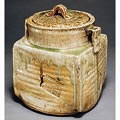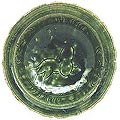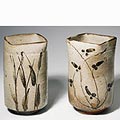 |
|
 |
 |
 |
 |
 |
 |
 |
 |
Japanese Stoneware
The production of high-fired, glazed stoneware in Japan expanded rapidly during the late 16th and early 17th centuries. One reason was the relocation of masses of Korean potters to Kyushu, the southern-most island of Japan, following Toyotomi Hideyoshi's invasion of Korea (1592-1598); this inaugurated new and wide-scale ceramic industries in the region. Another reason was the development of the tea ceremony, which grew from an esoteric ritual to a fashionable cultural phenomenon. Yet another factor was the growing middle class who, increasingly, used ceramics in daily life. The wabi aesthetic popularized by the tea master Sen no Rikyu (1522-1591) in the late 16th century encouraged the appreciation of understated and imperfect beauty. This aesthetic elevated the earthy and often distorted tea bowls, water jars, and flower vases made at domestic kilns over the previously favored sleek and flawless ceramics of Song China. Even as the dominant tastes of tea ceremony changed over time and more flamboyant pots came to be favored, the majority of Japanese stoneware from the Momoyama and early Edo periods continued to be characterized by unusual shapes, rich glaze colors and textures, and often highly individualistic and playful decorations. Stoneware production in Japan was remarkable for its incredible geographical diversity, as well as the technological and stylistic exchanges that flourished between the various kilns. Many of these manufactured not only tea ceremony utensils but also more utilitarian storage and tableware. |
 |
 |
| 1 thru 8 of 8 |
 |
| view text only list |
 |

Water Jar |
 |

Square Serving Dish |
 |

Square Serving Dish |
 |

Sake Bottle |
 |

Dish with Foliate Rim |
 |

Two Mukozuke Dishes |
 |

Tea Leaf Jar |
 |

Bowl |
 |
|
 |